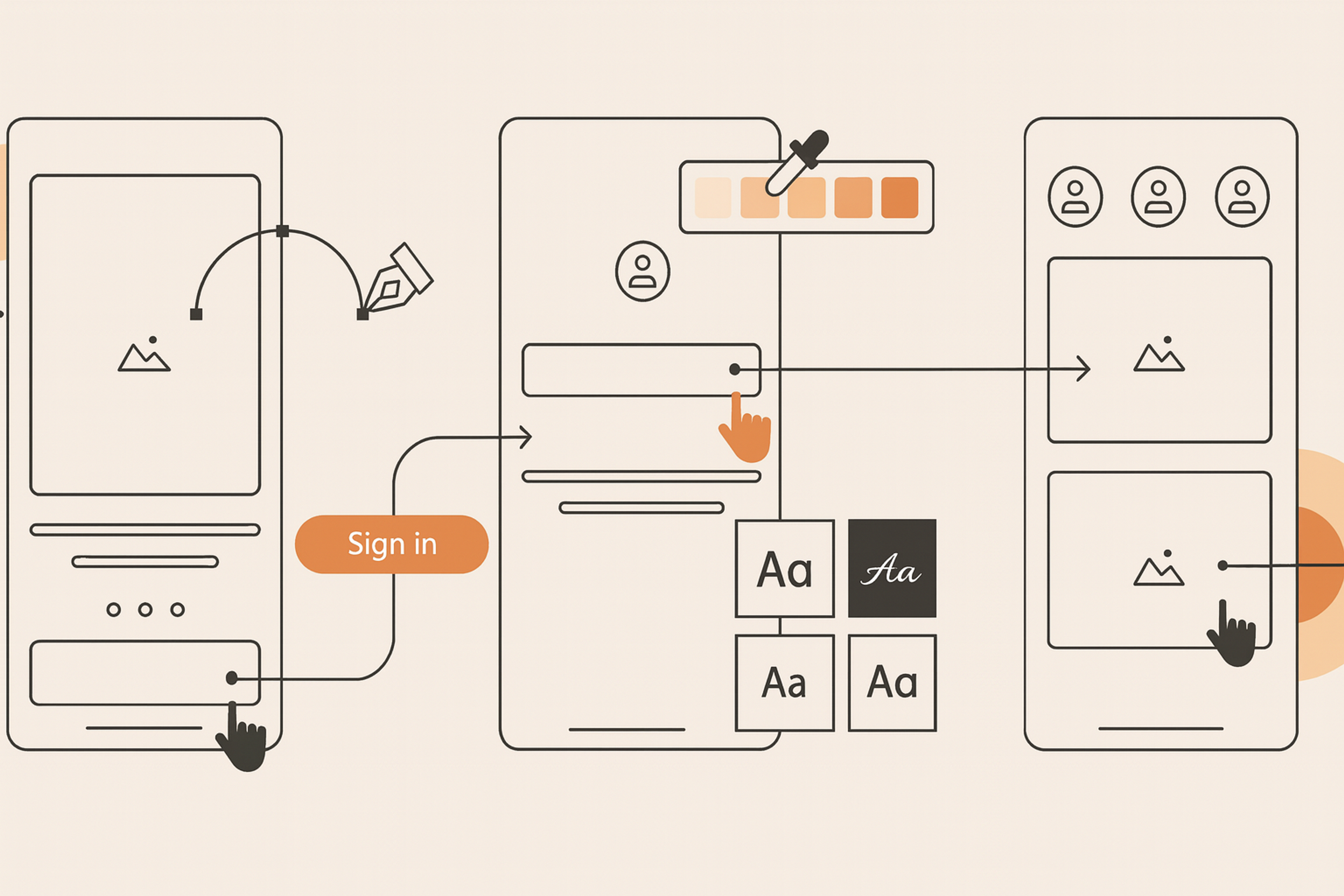Want to create products people actually love? The secret is design thinking. This problem-solving approach prioritizes users. You approach their shoes, ask the right questions, and turn complex challenges into innovative solutions.
Designers, developers, entrepreneurs, and problem solvers all benefit from this framework. It changes how you work. This guide breaks down the five stages and shows how to turn ideas into real impact.
What Is Design Thinking?
Design thinking helps teams solve complex problems creatively. It focuses on what customers need, value, and actually do. This human-centered method is often described as a design thinking methodology, design thinking model, or design thinking framework. These frameworks provide flexible structures for generating ideas quickly and getting results faster.
The process starts with deeply understanding users. You learn what people truly want from your product or service. Next, you define the exact problem based on real user data. A good problem statement centers on user needs, not business goals, keeping teams focused on the right solutions.
Five Stages of Design Thinking

Then comes brainstorming. Teams explore every possible solution, generating and considering possible, potential, and multiple solutions to the problem. After gathering ideas, you build prototypes that show your direction.
Finally, users test these prototypes and provide feedback. User testing is crucial for evaluating prototypes, gathering insights, and refining solutions based on real user reactions. This tells you exactly how to move forward.
The design thinking process typically includes five stages: Empathy, Definition, Ideation, Prototype, and Test. It is nonlinear and iterative, and teams often revisit earlier stages based on new insights gained during later phases.
Companies that use this approach create products customers love. They build loyalty that lasts. For crypto and Web3 companies, this matters even more. These technologies are complex and unfamiliar. Good design makes users feel confident in decentralized environments.
Why This Process Matters
Design thinking provides structure for creative teams. It encourages innovation instead of safe, traditional answers, and the framework makes challenging problems approachable.
Collaboration drives success, especially when cross-functional teams bring together diverse perspectives. Designers need to work together when generating ideas. More perspectives create better solutions. Workshops help diverse team members apply each stage effectively and provide hands-on methods for exploration.
Design Thinking Process Importanсe

Teams develop creative solutions tailored to customer needs. They gain valuable insights at every stage. Deep insights into user needs, behaviors, and motivations are uncovered, and the insights gained throughout the process inform each phase, from ideation to prototyping, ensuring user-centered and innovative outcomes. The iterative nature fosters collaboration. This makes it one of the most powerful techniques for creating successful products that deliver real value.
Our work with Fiverr shows this in action. We used an iterative approach that encouraged collaboration and creativity. The result? Products that offer genuine value and benefit users long-term.
Our work with Fiverr exemplifies this methodology, using an iterative approach that facilitates design thinking and encourages collaboration and creativity. This ensures that the final products or services offer real value and benefit users in the long term. The iterative and collaborative nature of design thinking makes it a powerful method for successful product development. It also enables design thinking facilitation in real-world projects that require diverse team input.
Fiverr Design by Clay
The Five Stages
1. Empathize: Understanding the Problem
Start by figuring out the real problem. Teams must conduct user research to understand what customers want and need. This user research reveals opportunities for improvement and provides deep insights.
Collect data from surveys, user interviews, and analytics. Learn who your customers are and why they behave in specific ways. This information helps you define the problem clearly. As you define the problem, explore the problem space to understand the context and challenges involved fully. Every decision you make will resonate with users.
Look at existing solutions before creating your own. Meet customer needs in ways current products don't. Don't reinvent what already works well.
Find potential improvements in existing products or services. Identifying unmet user needs can drive innovation and help teams focus on the most impactful changes. Teams can narrow their focus and address the right challenge. This stage shows what improvements matter and how to implement them.
Developing solutions becomes much easier when you know your audience and their needs.
Empathize Methods

2. Define: Clarify the Challenge
In the design thinking process, the define phase is where you take everything you learned and articulate the user problem clearly, based on data from your research. A well-formed problem statement focuses on user needs rather than business goals.
This guide guides teams through ideation and solution development. It keeps everyone focused on the user's perspective, and clarity at this stage prevents wasted effort later.
3. Ideate: Generate Solutions
Now generate ideas. Use your research to develop creative solutions tailored to users. This stage is about idea generation and divergent thinking and focusing on producing as many ideas as possible and exploring a wide range of possibilities without immediate judgment. Get as many ideas on paper as possible. Don't worry about quality yet.
Everyone on the team should contribute thoughts, no matter how unusual. Someone might say something illogical, but different perspectives spark new thoughts. Challenging assumptions during this phase often leads to creative ideas and new ideas that can drive innovation, which could lead to the perfect product. Nothing should be off-limits.
Consider practicality while brainstorming. You need ideas you can actually create within your budget and timeline. Understand how your concept would work in users' lives. Think about potential issues you can avoid.
Ideation lets teams flex their creative muscles while staying rooted in reality. Creative problem-solving is at the heart of this process, helping teams develop innovative yet practical solutions. Every solution becomes innovative and valuable. By leveraging each member's unique experiences, you'll create something that resonates with your audience.
4. Prototype: Build and Test
Bring your concept to life. Turn your abstract idea into something tangible that users can test. Use paper prototypes and scaled-down versions for quick, low-cost testing of your ideas. This step shows how well your solution fits into users' lives. You'll identify flaws before investing significant resources.
Prototyping lets you explore different solutions without full commitment. This helps teams figure out what works and what needs refining. Rapid prototyping allows you to quickly develop and test ideas while exploring the solution space to find the most effective approach. Less time and money are wasted.
Continuously iterate and refine solutions until they meet user expectations. The prototyping phase reveals weak links. You can improve them quickly.
Create multiple prototypes for real users to test. Design teams gain valuable insights that fine-tune the concept. Take in feedback from customers and experts. This ensures your solution serves its market while avoiding bad ideas. Prototyping is essential for developing innovative and practical design solutions.
Design Thinking Diagram

5. Test: Validate Your Solution with User Feedback
Testing is the final step before creating the actual product, known as the test phase. Teams refine their prototype until it meets user expectations. Then they test with potential customers who provide valuable feedback.
Usability testing is crucial during this stage. Observing real users interact with the prototype helps teams gather customer feedback, essential for improving the product and user experience.
This validates or challenges assumptions about real-world performance. Designers learn how users interact with products. The team identifies areas for improvement and applies user-centered design principles to ensure the solution meets user needs. They uncover possible issues early. Test under different conditions, like varying network speeds or device types.
Early problem identification gives developers time to find solutions before production begins. Testing in real situations with real users creates products that work harmoniously with their environment. They provide great experiences.
User involvement catches both obvious issues and subtle ones before release. Everyone avoids future headaches.
Testing Phase

After Testing: Implementation and Evaluation
Implementation
Teams bring their solution to life using insights from previous stages. They need to know how users will adopt what they've created, and they define success through clear metrics.
Set up a timeline for launch, plan pricing strategies and distribution channels, and create a plan for collecting data. This will make measuring performance and success easy.
Have clear short-term and long-term goals. Get user feedback throughout to ensure the solution meets needs over time. It won't evolve in harmful directions.
Execute these steps correctly, and you'll have something worth launching. You'll also collect information about user behavior that will prove valuable in future projects.
Evaluation
Evaluation is essential. Teams reflect on their work and see if they've met user needs. They identify areas for improvement. They determine how users interact with their solution over time.
Measure key performance indicators that show how well your product performs against goals. For example, look at customer satisfaction scores, usage frequency, or adoption rates.
Gather qualitative feedback too. Know what works well and what doesn't. This information guides future changes that better meet user needs.
Evaluation should happen throughout each iteration. Constantly examine data and listen to user feedback. Teams can keep improving their solutions to offer more value. Learn from past successes and failures. These lessons enhance future designs.
Best Practices
Follow these practices for a more effective, user-centered approach.
Empathize with users. Develop a deep understanding through interviews, contextual inquiries, and participatory design.
Foster cross-disciplinary collaboration. Engage stakeholders from engineering, marketing, and business strategy. Create well-rounded solutions with holistic problem-solving. Involve the entire team in the creative design and creative process to ensure diverse perspectives and collective ownership, which are essential for success.
Promote experimentation. Build a culture that embraces creative exploration, iterative testing, and calculated risk-taking. Prototype quickly and refine based on real insights. Design thinking helps solve business challenges and provides a competitive advantage in the business world by encouraging innovative approaches to problem-solving.
Engage users throughout. Engage users at every stage, from empathy-building to prototype testing. Their feedback validates assumptions, refines solutions, and enhances usability. Focusing on customer experience drives business success by ensuring products and services truly meet user needs.
Stay flexible. Be open to adjusting strategies based on user feedback, market changes, or discoveries throughout development. Design thinking is widely used in software development and other design processes to generate innovative ideas and create solutions that adapt to changing requirements.
Measure and iterate. Continuously assess effectiveness using qualitative and quantitative data. Use insights to refine and improve designs until you achieve an optimal product or service. This process leads to impactful solutions and helps create innovative solutions for ill-defined and complex problems, always focusing on human beings and applying human-centered design principles.
FAQ
What Is the Meaning of the Design Thinking Process?
Design thinking is a human-centered approach to problem-solving that blends creativity, empathy, and experimentation to produce effective solutions.
What Are the 5 Steps in the Design Thinking Process?
The five stages are Empathize, Define, Ideate, Prototype, and Test. Each stage helps teams understand users, explore ideas, and refine practical solutions.
What Are the 7 Steps of the Design Thinking Process?
Some extended models include Empathize, Define, Ideate, Prototype, Test, Implement, and Evaluate. This adds real-world execution and feedback loops.
What Is the Design Process?
The design process is a structured workflow for turning ideas into functional solutions, moving from research and brainstorming to testing and iteration.
What Is Design Thinking in a Nutshell?
Design thinking means solving problems like a designer: understanding users deeply, experimenting quickly, and improving through feedback and iteration.
Read More
Conclusion
Design thinking is more than a process. It's a mindset shift. It empowers teams to build with real people in mind. You create solutions that truly matter.
Follow the five stages: empathize, define, ideate, prototype, and test. You're not guessing what users want. You're uncovering real needs and designing with purpose.
The beauty lies in flexibility and heart. Talk to users, gather feedback, refine ideas, and stay grounded in what works. No matter the industry or challenge, this approach helps you tackle complexity with clarity and creativity.
True innovation isn't about making something new. It's about creating something meaningful.


About Clay
Clay is a UI/UX design & branding agency in San Francisco. We team up with startups and leading brands to create transformative digital experience. Clients: Facebook, Slack, Google, Amazon, Credit Karma, Zenefits, etc.
Learn more

About Clay
Clay is a UI/UX design & branding agency in San Francisco. We team up with startups and leading brands to create transformative digital experience. Clients: Facebook, Slack, Google, Amazon, Credit Karma, Zenefits, etc.
Learn more


